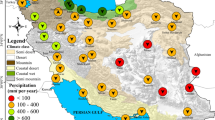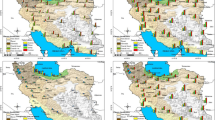Abstract
This study investigates the spatiotemporal characteristics of meteorological drought over the past 50 years in Iran's four distinct climates: Hyper-arid, Arid, Semiarid, and Humid. Employing three drought indices (Standardized Precipitation Index, Reconnaissance Drought Index, and Standardized Precipitation Evapotranspiration Index) at multiple timescales (1-, 3-, 6-, 9-, and 12-months), the analysis utilizes data from 41 synoptic meteorological stations spanning the period from 1969 to 2019. Results reveal a temporal increase in the duration and intensity of drought events, particularly post the 1998–99 period. The longest extreme drought, lasting 40 months, occurred during Dec 1998–Mar 2002 and Jan 2018–Mar 2018. Spatial patterns indicate a uniform rise in drought intensity across timescales and indices, transitioning from humid and semiarid to arid and Hyper-arid regions. Average drought durations for SPI, SPEI, and RDI indices are 9, 12, and 9 months, respectively, while mean drought frequencies stand at 14%, 17%, and 13% for SPI, SPEI, and RDI indices. Notably, SPEI exhibits greater duration and frequency of drought events, especially in arid and Hyper-arid regions. The research underscores the pivotal role of climatic variables in delineating drought characteristics and emphasizes the significance of selecting appropriate drought indices across diverse climates.








Similar content being viewed by others
Data availability
All data used in this paper for Iran were extracted from metrological stations’ data and can be requested from the corresponding author.
Code availability
Not applicable.
References
Abubakar HB, Newete SW, Scholes MC (2020) Drought characterization and trend detection using the reconnaissance drought index for Setsoto Municipality of the Free State Province of South Africa and the impact on maize yield. Water 12(11):2993
Adnan S, Ullah K, Shuanglin L, Gao S, Khan AH, Mahmood R (2018) Comparison of various drought indices to monitor drought status in Pakistan. Climate Dynamics 51:1885–1899
Allen RG, Pereira LS, Raes D, Smith M (1998) Crop evapotranspiration-Guidelines for computing crop water requirements-FAO Irrigation and drainage paper, 56, vol 300, no 9. Fao, Rome, pp D05109
Banimahd SA, Khalili D (2013) Factors influencing Markov chains predictability characteristics, utilizing SPI, RDI, EDI and SPEI drought indices in different climatic zones. Water Resour Manag 27:3911–3928
Bazrafshan J, Hejabi S (2018) A non-stationary reconnaissance drought index (NRDI) for drought monitoring in a changing climate. Water Resour Manag 32:2611–2624. https://doi.org/10.1007/s11269-018-1947-z
Beguería S, Vicente-Serrano SM, Reig F, Latorre B (2014) Standardized precipitation evapotranspiration index (SPEI) revisited: Parameter fitting, evapotranspiration models, tools, datasets and drought monitoring. Int J Climatol 34:3001–3023
Byakatonda J, Parida BP, Moalafhi DB, Kenabatho PK (2018) Analysis of long term drought severity characteristics and trends across semiarid Botswana using two drought indices. Atmos Res 213:492–508. https://doi.org/10.1016/j.atmosres.2018.07.002
Du L, Tian Q, Yu T et al (2013) A comprehensive drought monitoring method integrating MODIS and TRMM data. Int J Appl Earth Obs Geoinf 23:245–253. https://doi.org/10.1016/j.jag.2012.09.010
Gocic M, Trajkovic S (2014) Analyse des tendances des données d’évapotranspiration de référence en climat humide. Hydrol Sci J 59:165–180. https://doi.org/10.1080/02626667.2013.798659
Güner Bacanli Ü (2017) Trend analysis of precipitation and drought in the Aegean region, Turkey. Meteorol Appl 24:239–249. https://doi.org/10.1002/met.1622
Haile GG, Tang Q, Hosseini-Moghari SM et al (2020) Projected impacts of climate change on drought patterns over East Africa. Earth’s Futur 8:1–23. https://doi.org/10.1029/2020EF001502
Hao Z, AghaKouchak A (2013) Multivariate standardized drought index: a parametric multi-index model. Adv Water Resour 57:12–18. https://doi.org/10.1016/j.advwatres.2013.03.009
Kendall MG (1938) A new measure of rank correlation. Biometrika 30(1/2):81–93
Kumar Raju BC, Nandagiri L (2017) Analysis of historical trends in hydrometeorological variables in the upper Cauvery Basin, Karnataka, India. Curr Sci 112:577–587. https://doi.org/10.18520/cs/v112/i03/577-587
Liu Z, Wang Y, Shao M et al (2016) Spatiotemporal analysis of multiscalar drought characteristics across the Loess Plateau of China. J Hydrol 534:281–299
Madani K (2014) Water management in Iran: What is causing the looming crisis? J Environ Stud Sci 4:315–328. https://doi.org/10.1007/s13412-014-0182-z
Mahajan DR, Dodamani BM (2016) Spatial and temporal drought analysis in the Krishna River basin of Maharashtra, India. Cogent Eng 3(1):1185926
Mahmoudi P, Rigi A, Miri Kamak M (2019) A comparative study of precipitation-based drought indices with the aim of selecting the best index for drought monitoring in Iran. Theor Appl Climatol 137:3123–3138. https://doi.org/10.1007/s00704-019-02778-z
Mann HB (1945) Nonparametric tests against trend. Econom J Econom Soc 245–259
McKee TB, Doesken NJ, Kleist J (1995) Drought monitoring with Multiple Time scales. Proceeding of the Ninth Conference on Applied Climatology. American Meteorological Society, Dallas, TX, pp 233–236
McKee TB, Doesken NJ, Kleist J (1993) The relationship of drought frequency and duration to time scales. Proceeding of the 8th Conference on Applied Climatology. American meteorological society, Boston, pp 179–184
Mohammed R, Scholz M (2019) Climate variability impact on the spatiotemporal characteristics of drought and aridityin arid and semi-arid regions. Water Resour Manag 33:5015–5033. https://doi.org/10.1007/s11269-019-02397-3
Mohammed R, Scholz M (2017) The reconnaissance drought index: a method for detecting regional arid climatic variability and potential drought risk. J Arid Environ 144:181–191. https://doi.org/10.1016/j.jaridenv.2017.03.014
Moshir Panahi D, Kalantari Z, Ghajarnia N et al (2020) Variability and change in the hydro-climate and water resources of Iran over a recent 30-year period. Sci Rep 10:1–9. https://doi.org/10.1038/s41598-020-64089-y
Pathak AA, Dodamani BM (2020) Comparison of meteorological drought indices for different climatic regions of an Indian river basin. Asia-Pacific J Atmos Sci 56:563–576. https://doi.org/10.1007/s13143-019-00162-5
Pettitt AN (1979) A non-parametric approach to the change-point problem. J R Stat Soc Ser C Applied Stat 28:126–135
Rahimi J, Malekian A, Khalili A (2019) Climate change impacts in Iran: assessing our current knowledge. Theor Appl Climatol 135:545–564. https://doi.org/10.1007/s00704-018-2395-7
Sharafati A, Nabaei S, Shahid S (2020) Spatial assessment of meteorological drought features over different climate regions in Iran. Int J Climatol 40:1864–1884. https://doi.org/10.1002/joc.6307
Spinoni J, Naumann G, Carrao H et al (2014) World drought frequency, duration, and severity for 1951–2010. Int J Climatol 34:2792–2804. https://doi.org/10.1002/joc.3875
Subash N, Ram Mohan HS (2011) Trend detection in rainfall and evaluation of standardized precipitation index as a drought assessment index for rice–wheat productivity over IGR in India. Int J Climatol 31:1694–1709
Surendran U, Anagha B, Raja P et al (2019) Analysis of drought from humid, semi-arid and arid regions of india using DrinC model with different drought indices. Water Resour Manag 33:1521–1540. https://doi.org/10.1007/s11269-019-2188-5
Svoboda M, Hayes M, Wood D (2012) Standardized precipitation index user guide. 2540 World Meteorological Organization Geneva, Switzerland
Tabari H, Abghari H, Hosseinzadeh Talaee P (2012) Temporal trends and spatial characteristics of drought and rainfall in arid and semiarid regions of Iran. Hydrol Process 26:3351–3361. https://doi.org/10.1002/hyp.8460
Tigkas D, Vangelis H, Tsakiris G (2012) Drought and climatic change impact on streamflow in small watersheds. Sci Total Environ 440:33–41. https://doi.org/10.1016/j.scitotenv.2012.08.035
Tigkas D, Vangelis H, Tsakiris G (2015) DrinC: a software for drought analysis based on drought indices. Earth Sci Informatics 8:697–709. https://doi.org/10.1007/s12145-014-0178-y
Tsakiris G, Pangalou D, Vangelis H (2007) Regional drought assessment based on the Reconnaissance Drought Index (RDI). Water Resour Manag 21:821–833. https://doi.org/10.1007/s11269-006-9105-4
Tsakiris G, Vangelis H (2005) Establishing a drought index incorporating evapotranspiration. Eur Water 9:3–11
UNESCO (1979) Map of the world distribution of arid regions. Tech Rep, The United Nations Educational, Scientific and Cultural Organization (UNESCO), Paris, France
Vangelis H, Tigkas D, Tsakiris G (2013) The effect of PET method on Reconnaissance Drought Index (RDI) calculation. J Arid Environ 88:130–140. https://doi.org/10.1016/j.jaridenv.2012.07.020
Vicente-Serrano SM, Beguería S, López-Moreno JI (2010) A multiscalar drought index sensitive to global warming: the standardized precipitation evapotranspiration index. J Clim 23:1696–1718. https://doi.org/10.1175/2009JCLI2909.1
Wang F, Wang Z, Yang H, Zhao Y (2018) Study of the temporal and spatial patterns of drought in the Yellow River basin based on SPEI. Sci China Earth Sci 61:1098–1111. https://doi.org/10.1007/s11430-017-9198-2
Xu L, Chen N, Zhang X (2019) Global drought trends under 1.5 and 2 C warming. Int J Climatol 39:2375–2385
Zhang Q, Qi T, Singh VP et al (2015) Regional frequency analysis of droughts in China: a multivariate perspective. Water Resour Manag 29:1767–1787
Acknowledgements
The authors are particularly grateful to the Arak University and Iran Meteorological Organization (IRIMO).
Funding
This research received no external funding.
Author information
Authors and Affiliations
Contributions
Data collection and initial analysis were performed by Jalil Helali and Ebrahim Asadi Oskouei. Material preparation and calculations were performed by Mehdi Mohammadi Ghaleni, Saeed Sharafi and Seyed-Mohammad Hosseini-Moghari. The first draft of the manuscript was written by Mehdi Mohammadi Ghaleni and all authors commented on previous versions of the manuscript. All authors read and approved the final manuscript.
Corresponding author
Ethics declarations
Ethics approval
Not applicable.
Consent to participate
Not applicable.
Consent for publication
Not applicable.
Conflict of interest
The authors declare no conflict of interest.
Additional information
Publisher's Note
Springer Nature remains neutral with regard to jurisdictional claims in published maps and institutional affiliations.
Rights and permissions
Springer Nature or its licensor (e.g. a society or other partner) holds exclusive rights to this article under a publishing agreement with the author(s) or other rightsholder(s); author self-archiving of the accepted manuscript version of this article is solely governed by the terms of such publishing agreement and applicable law.
About this article
Cite this article
Mohammadi Ghaleni, M., Sharafi, S., Hosseini-Moghari, SM. et al. Temporal evolution and spatial variation of meteorological drought characteristics in Iran's diverse climates over the past half century. Theor Appl Climatol (2024). https://doi.org/10.1007/s00704-024-04941-7
Received:
Accepted:
Published:
DOI: https://doi.org/10.1007/s00704-024-04941-7




